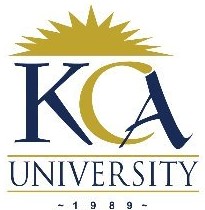 UNIVERSITY EXAMINATIONS: 2011/2012
UNIVERSITY EXAMINATIONS: 2011/2012
SECOND YEAR EXAMINATION FOR THE BACHELOR OF
SCIENCE IN INFORMATION TECHNOLOGY
BIT 2208 PRINCIPLES OF DATA COMMUNICATIONS
DATE: JULY, 2012 TIME: 2 HOURS
INSTRUCTIONS: Answer Question ONE and any other TWO
QUESTION ONE
a) Define the following terms as they relate to data communication.
i. Consistence [1 Mark]
ii. Recovery [1 Mark]
iii. Time Division Multiplexing [1 Mark]
iv. Cut-through switching [1 Mark]
v. Attenuation [1 Mark]
b) Data transmission is the conveyance of any kind of information from one space to
another. Differentiate between the following:
i. Serial transmission and parallel transmission [2 Marks]
ii. Synchronous transmission and asynchronous transmission [2 Marks]
iii. Protocols and handshaking [2 Marks]
c) Describe briefly how the following error correction schemes work:
i. Automatic repeat-request (ARQ) [2 Marks]
ii. Forward error correction (FEC) [2 Marks]
d) Discuss briefly the factors that should be considered when selecting a WAN
service. [5 Marks]
e) i. Distinguish between a Layer 3 switch and a Router. [2 Marks]
ii. Why is it necessary to encode data before transmission? [2 Marks]
f) Differentiate between “Polar” and “Bipolar” as they relate to encoding. [4 Marks]
g) Distinguish between Flow and Congestion control. [2 Marks]
QUESTION TWO
a) Why are there two (2) separate frequencies used for uplink and downlink
transmission in case of satellite communication? [3 Marks]
b) Why is serial transmission commonly used in data communication? [3 Marks]
c) List the functions performed by the physical layer of the 802.3 standard. [4 Marks]
d) Identify and discuss the three (3) steps involved in data communication through
circuit switching. [4 Marks]
e) What is the difference between bit and baud with respect to transmission? Can they
be equivalent? Can they be non-equivalent? [6 Marks]
QUESTION THREE
a) An e-mail application requires connections of various components between the
sender and the receiver of an email. Discuss the components that make up the
communication system if one person sends an e-mail to another person. [6 Marks]
b) Explain the functions of each of the seven layers of the OSI Reference Model.
[7 Marks]
c) Describe the two levels of ISDN services (BRI and PRI). [7 Marks]
QUESTION FOUR
a) Using the bit stream provided, encode using the following encoding schemes:
1 1 0 1 1 0 0 0 1 0 1
i. Non-Return to Zero Inverted [2 Marks]
ii. Pseudotenary [2 Marks]
iii. Differential Manchester [2 Marks]
b) Discuss two (2) application areas of Frequency Division Multiplexing. [2 Marks]
c) i. Briefly explain the reasons behind the layered approach in the facilitation
of communication in data communication systems. [8 Marks]
ii. List any four (4) basic principles followed in layering. [4 Marks]
QUESTION FIVE
a) The simplest form of flow control is known as stop-and-wait flow control. How
does it work? [4 Marks]
b) “X.25 is a standard that defines the connection between a terminal and a packet
Switched network (PSN)……” Explain the benefits of using this standard in Wide
Area Network connections. [4 Marks]
c) Explain why conventional congestion control schemes are inadequate for ATM
networks. [6 Marks]
d) Standards ensure interoperability between devices made by different
manufacturers. Internationally, the three key organizations influencing WLAN
standards are ITU-R, IEEE and Wi-Fi Alliance. Discuss the roles of each of these
organizations as standards bodies for WLANs. [6 Marks]
